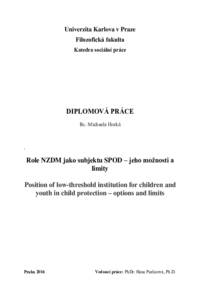Role NZDM jako subjektu SPOD - jeho možnosti a limity
Position of low-threshold institution for children and youth in Child protection - options and limits
diplomová práce (OBHÁJENO)

Zobrazit/
Trvalý odkaz
http://hdl.handle.net/20.500.11956/74066Identifikátory
SIS: 158513
Katalog UK: 990020955960106986
Kolekce
- Kvalifikační práce [24991]
Autor
Vedoucí práce
Oponent práce
Matoušek, Oldřich
Fakulta / součást
Filozofická fakulta
Obor
Sociální práce
Katedra / ústav / klinika
Katedra sociální práce
Datum obhajoby
21. 6. 2016
Nakladatel
Univerzita Karlova, Filozofická fakultaJazyk
Čeština
Známka
Velmi dobře
Klíčová slova (česky)
Nízkoprahové zařízení pro děti a mládež (NZDM), Sociálně-právní ochrana dětí (SPOD), OSPOD, spolupráceKlíčová slova (anglicky)
Low-threshold institution for children and youth, Child protection, Department of Social and legal protection for Children, cooperationPráce se zabývá rolí Nízkoprahového zařízení pro děti a mládež (NZDM) v systému sociálně-právní ochrany dětí, jeho významem, možnostmi a spoluprací s dalšími subjekty, zejména s OSPOD. Teoretická část se věnuje vymezení sociálně-právní ochrany, možnostem spolupráce mezi jednotlivými subjekty, oznamovací a informační povinnosti a dále je pozornost věnována OSPOD, NZDM a pověřeným osobám (jejich roli, náplni práce, specifikům aj.) Praktická část je zaměřena na tři základní okruhy, na to zda mají NZDM pověření k SPOD (a srovnání jeho výhod a nevýhod), dále na samotnou roli NZDM v systému SPOD (na jeho cílovou skupinu, možnosti pomoci klientům a spolupráci s dalšími subjekty) a v neposlední řadě na spolupráci s OSPOD. Výzkumné otázky jsou zodpovídány prostřednictvím kvalitativní (rozhovory) i kvantitativní (dotazníkové šetření) metodologie
The thesis focuses on the role of Low-threshold institutions for children and youth (NZDM) in the system of social- legal Child protection, their significance, possibilities and cooperation with other subjects, namely with Department of Social and Legal Protection for Children (OSPOD). The theoretical part defines what the social and legal protection for children is responsible for, how the cooperation between individual subjects work and what notification and information obligations are the subjects bound to fulfil. Attention is also paid to the tasks of OSPOD, NZDM and the role of entrusted persons in the system. The practical part is focused on three main topics. 1) Do the NZDMs have an authorisation to perform social and legal protection of children (and advantages and disadvantages associated with it)? 2) What is the role of NZDM in the system of Child protection (With what clients they work? How can NZDMs help their clients? And do they cooperate with other subjects)? 3) How does the cooperation with OSPOD works?The qualitative (interviews) as well as quantitative (questionnaires) methods have been used during the research.
